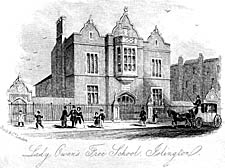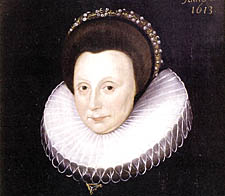
Above: Lady Owen’s School in the mid-19th century and below, Dame Alice painted in 1613
 |
The mysterious Dame whose legacy lives on
Few schools owe their origin to a cow, a village maiden and an archer’s arrow, writes Mary Cosh
Alice Owen: The Life, Marriages and Times of a Tudor Lady by Clive Rose
Phillimore and Co, £15.95 order this book
PRACTICALLY everyone who has lived in Islington knows of Dame Alice Owen, her fabled girlhood escape from impalement by an arrow, and how in gratitude she founded almshouses and Dame Alice Owen’s School.
Many a resident, from old age downwards, was once a pupil of that school, at its original site near the Angel or its present home at Potters Bar. But few in Islington or elsewhere know much, indeed anything, of her life and character, for the available facts are bare.
Now a ninth-generation descendant, Sir Clive Rose, living in Hampshire, has produced her biography, fleshing out by largely circumstantial evidence the skeletal data to bring to life her marriages, character, family, and the story of her famous charitable foundations.
Opening chapters illuminate, socially and historically, mid-Tudor England and the City of London, with accounts of the Brewers’ and Mercers’ Companies into which Alice married; other chapters cover the families of her three husbands – these last unavoidably rather dry, limited to the basics of marriages, descents and professions, the most interesting probably being the Owens, of Welsh and border ancestry.
Alice herself was the daughter of a mere Islington innkeeper, Thomas Wilkes, well-to-do but of no social significance.
We know she was born in 1547, had an older sister Margery and brother Robert, and three step-siblings by her father’s second marriage.
The sole known event in Alice’s girlhood is the famous tale of an arrow shot by a Finsbury archer in the fields, which pierced her tail hat as she was indulging a whim to milk a cow, and how her narrow escape inspired a vow of a deed of gratitude should she ever “become a lady”.
Otherwise, we are dependent on general descriptions of life in rural Islington, composition of a household, education of girls, cooking, shopping – and especially childbearing, in which Alice was for 15 years to be almost continuously engaged. These were her 10 children by her husband Henry Robinson, a successful brewer from Egremont in Cumberland, whom Alice married in 1570 at the age of 23.
Although she then lived in the City, at first in Chancery Lane, Alice remained close in feeling and association to Islington. Most of her children died in infancy, and she was pregnant with the 11th, Henry, when her husband died aged only 42.
Widowed at 38, she was already on the up-and-up, and so her life continued, remarrying when Henry, her sole surviving son, was only three months old; and when he was only 18 months old she bore a daughter, Ursula, to her new husband the mercer William Elkin, a childless, sexagenarian widower from Staffordshire.
A remarkable event in this period is the extraordinary adventure of Margaret Robinson, Alice’s eldest daughter, who was in the care of a freeman of the Ironmongers’ Company.
When she was only 12, then legally of marriageable age, she was abducted by an adoring admirer, John Skinner, who hoped to marry her, but was thwarted by her stepfather Elkin, and during a prolonged legal action the unfortunate young man vanished – probably murdered.
Margaret’s mother Alice quickly married her off to John Brett, an Oxford graduate and well set-up landowner.
Aside from this drama, we may picture a comfortable, even luxurious life for Alice as wife or widow, in a rich merchant’s timber-framed house in Bassishaw Street, with five children at home and a fleet of servants.
William Elkin would very likely have become Lord Mayor and a knight as well, had he not died in 1593 in one of London’s recurrent plagues.
The ambitious Alice soon set about acquiring gentility for her late husband by the posthumous grant of a coat of arms, with right of descent to their daughter Ursula.
Two years later in 1595 she went one better and acquired an estate, Cransley Hall near Kettering, important for her own jointing the gentry, and which she settled on her son Henry Robinson.
Very shortly, she married Thomas Owen, lawyer and Serjeant-at-Arms, and not surprisingly she successfully applied for her own coat-of-arms in the name of Alice Wilkes, wife to Judge Owen. This gained for her the title of Dame.
From these recorded facts we know her ambition, her determination and strength of character, devotion to the Reformed religion – and strong constitution (all those children, and outliving three husbands).
Owen died in 1598, leaving, like his predecessors, generous bequests to his widow, his children by his first marriage, and as was customary, to charity.
Alice’s own great gift to posterity occupied her last years after Owens’ death.
In 1608 she founded a row of almshouses for 10 poor widows of the Brewers’ Company, and from 1610 planned a school for 30 “sons and daughters of Islington” – 24 in Islington and six in Clerkenwell (though in fact no girls were admitted until 1886).
The land acquired by the Brewers’ Company, who maintained control of the institution, was 11 acres of Ermintage Fields near the Angel, then Crown lands but originally the site of the chapel of the Knights Hospitaliers of St John of Jerusalem, whose priory in Clerkenwell was nearby.
The syllabus was Latin grammar, very elementary arithmetic, religious instruction in the new Bible Authorised Version and the liturgy, and little else.
Alice Owen saw not even the school’s infancy. Though fully dealt with in her will, she died in her Basinghall house in 1613 with the school barely started.
The remainder of the book deals with its history, its early vicissitudes and later distinction, and with the lives of Alice’s descendants.
The alsmshouses were abolished in 1878 and replaced by pensions for 14 widows, and the girls’ school was built 276 years after it had been authorised by King James I. The school moved to Potters Bar in 1972.
Dame Alice was buried at her beloved St Mary’s Church, Islington, and a fine monument bore her statue, the kneeling figures of 11 child descendants, and a long inscription in her praise. But when the church was rebuilt in 1751 it was in too poor condition to remove to the new building, and only the figures of the children could be saved, and re-erected at the school. They are now at Potters Bar, where a small figure of Alice, probably from the almshouses, also survives.
Nor have we her original portrait, painted for the Brewers’ Company in 1610, which was destroyed in World War II, but a fine copy from 1840 is also at the school, and a statue based on fragments of the tomb’s original was made by George Frampton in 1897.
Alice’s true monument, besides the few physical relics, is in her school and its living pupils, past and present.
|



